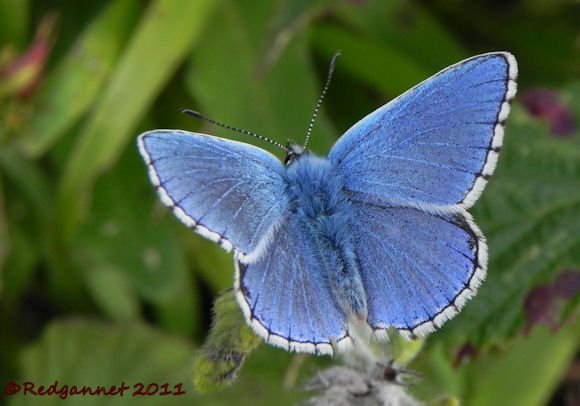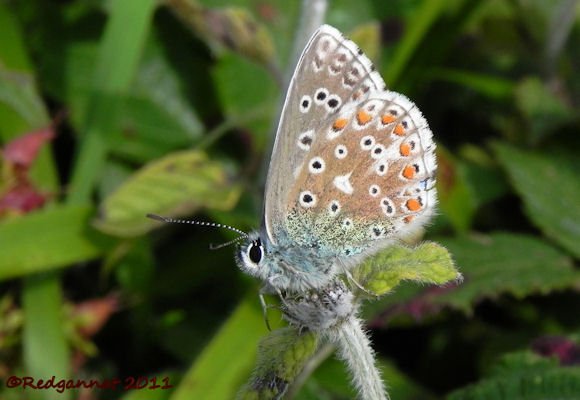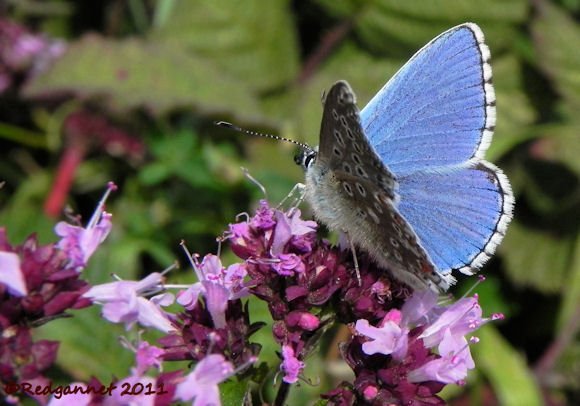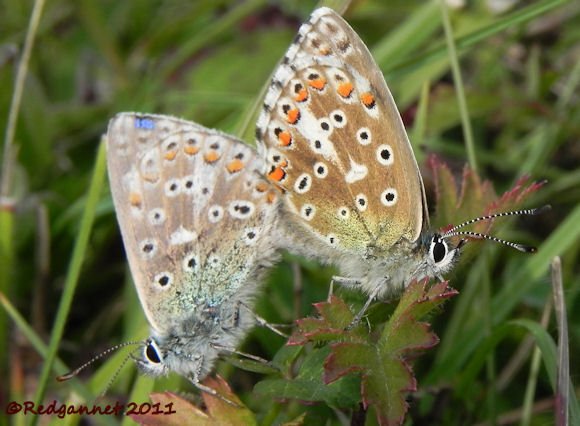First let me put forward my credentials for writing about butterflies. This is the second time that I have been butterfly watching and…..well, actually, that’s about it. A young enthusiast, who blogs under the name of ForestPuffin, introduced me to the discipline when he came to visit at the end of August and I became quite captivated by the object of our outing, the Adonis Blue Butterfly. ForestPuffin was targeting this species as it is very habitat dependent and, unbeknownst to me, such habitat exists within a big stone’s throw of my house. I wrote a post for Redgannet at the time, but felt so enamoured with this tiny creature that I was pulled to return, with my beautiful assistant (my wife Helen), for a better look.
Queendown Warren, just north of Maidstone, Kent, provides the perfect conditions for this small, specialist butterfly. It relies on a number of factors for success, first of which is a closely-cropped south-facing, sunny, chalky slope. Second they are reliant on Horseshoe Vetch on which they lay their eggs and on which the caterpillars feed. Being so particular in their preferences can be restrictive; they are extremely sedentary having very little interaction with neighbouring colonies. The collapse of the UK rabbit population during the myxomatosis outbreak in the 1950’s allowed the previously well-cropped vetches to grow long and lush, lowering the ground temperature and the butterflies were wiped out from much of southern England within two years. Only in their strongholds of Dorset and the Isle of Wight did they survive in viable numbers. Lepidopterists were concerned that they might not endure see the 21st century.
Rabbits are now thriving again after recovering their numbers and the Kent Wildlife Trust has implemented a grazing policy at Queendown Warren, with sheep and cattle, to supplement the rabbits’ efforts. Thus it was that in 2002 a re-introduction scheme successfully brought the Adonis Blue Butterfly back to the North Downs. It was a fascinating story to follow and the happy ending made it all the more touching, but a tiny bit of extra research brought even more exciting details of the secret life of the ‘blue’ family. Anyone who habitually uses the term ‘blue’ to describe a family of butterflies is probably already way ahead of me at this stage, but I am very new to the world of the Lycaenidae and was fascinated to find out about their relationship with ants.
Ants guard and tend the caterpillars, offering protection against predators and herding them in the evenings to the warmth of the ground, even ‘tucking them in’ if the soil is loose enough to cover them over. The ants, for their troubles, are rewarded with honeydew excreted from a gland on the caterpillar’s body. Communication between the ants and caterpillar can re-unite a wayward caterpillar that has become separated from its chaperones. Many ‘blue’ chrysalises are found within ant nests, enjoying the warmth and protection until they emerge as adults. During this time the chrysalis is constantly attended by the ants and it is thought unlikely that the species would be able to survive without the ants’ ministration.
At Queendown Warren, the Adonis Blues are just coming to the end of their second-brood flight season which covers the month from the middle of August to the middle of September. During this time their preferred food plant, Marjoram, has been flowering, but as they approach the end of their lives some of the adults were looking very tatty. Others however were building on the success of the re-introduction scheme by ensuring that there is a new population for next season. The male is on the left.
I have invested in a book, “The Butterflies of Britain and Ireland” by Jeremy Thomas and Richard Lewington, from which most of the information above has been transposed. It is a treasure of a book for anyone with an interest in British and Irish butterflies and treats the subject with a passion and depth that is unsurpassed in any other popular publication.















And there’s an ecology lesson for the day, wrapped in a pretty blue package. Ants and bunnies are critical for the butterflies. Who would have thought?
“When we try to pick out anything by itself, we find it hitched to everything else in the universe.” – John Muir
Good to meet you at Leybourne Lakes today and hope you saw the bittern.
Your post on adonis blue looks fine. There is now some evidence that they are dispersing for longer distances and colonising new sites on the downs in Kent. I have found several new sites in the last few years.